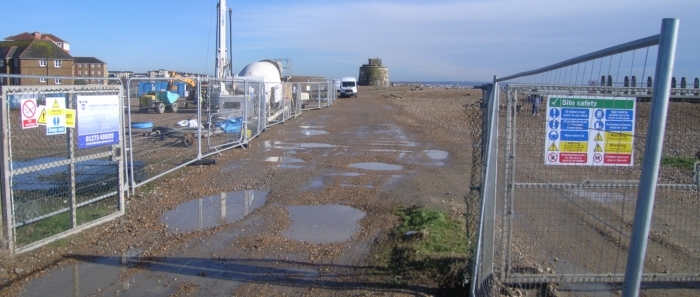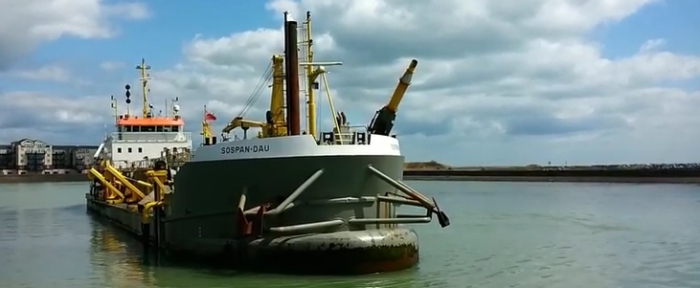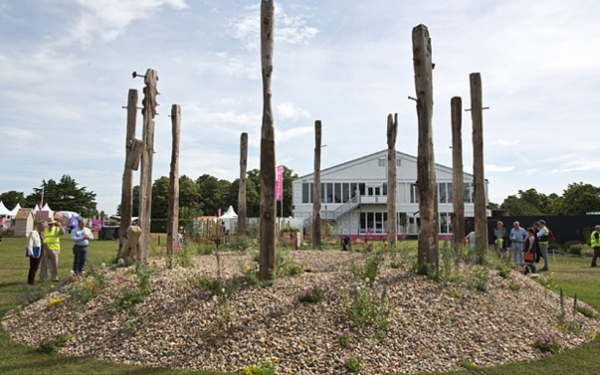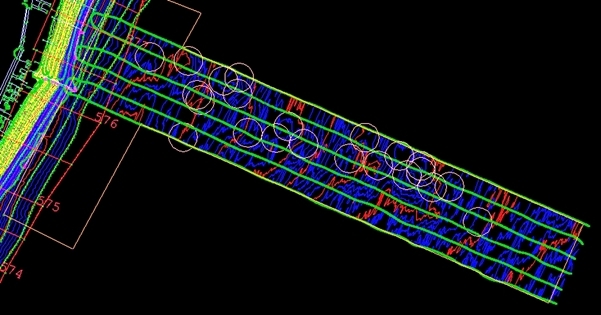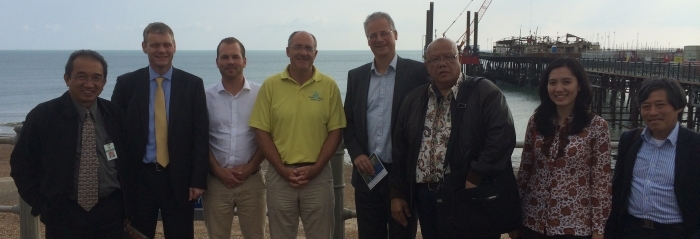Latest News
This section contains information on the Latest News and Latest Works relating to the sea defences, and the variety of Beach Maintenance tasks that are employed to sustain them
Emails to BT Accounts
October 2020
In the last week all PCDL emails sent to BT email accounts have been returned as spam, showing as;
failed: btinternet.com: 554 Message rejected, policy (3.2.1.1) ID (5ED70F9C1401BB98) - Your message looks like SPAM or has been reported as SPAM.
If anyone using btinternet wishes to continue receiving PCDL emails, they will need to add our address to their safe senders list, or alternatively use a different account to receive news of beach works.
Considerate Constructors Silver Award
September 2020
The Pevensey Bay Sea Defences project has been given a Considerate Constructors Silver Award for a third consecutive year in 2020. Normally awarded in spring, ceremonies were initially delayed because of COVID-19, and then cancelled prior to awards being announced in late September. The site now has 16 awards, retaining its position as the most decorated site in the scheme's history.
University of Southampton Research
September 2020
Despite an agreement being signed in February this year, COVID-19 restrictions have meant that a three year research project into how sediment moves through Pevensey Bay is only just starting on site. The project aims to improve understanding of how sediment moves below the main sea defence embankment using lines of instruments placed on the sea bed. It also hopes to develop a rapid response survey methodology using autonomous vessels that can measure sea bed levels through 5m of water so surveys can be at almost any state of the tide rather than just at low water on spring tides.
Considerate Constructors Silver Award
May 2019
The Pevensey Bay Sea Defences project has been given a Considerate Constructors Silver Award for 2019. The site now has 15 awards, which, according to scheme organisers, makes the site the most decorated in the scheme's history.
Site 1 Closed to Public Access during Bypassing Works
September 2017
Development Site 1, between Martello tower No.66 and Langney Point roundabouts, has been an open space since the stockpile of shingle created by Carillion was moved in 2003. For the last 14 years pedestrians have been able to walk across the site without coming into close contact with lorries moving shingle. Now more than half the site has been fenced off to allow construction of 10 new properties to begin. In doing so this has closed the unofficial footpath and directed all pedestrians to the track used by the lorries. For most of the year, when lorries are not working, this is not a problem. But when bypassing works start, there is no longer sufficient space for two-way running of lorries, let alone a safe footway for walkers. Therefore we have no choice but to temporarily close the remainder of the site to the public. Fortunately, there is a readymade diversion from Sovereign Harbour esplanade down on to Martinique Way and round the footpath to Langney roundabout, and hence onto Eastbourne Seafront. In future, all pedestrians will be diverted this way during times when lorries are running. The area will be accessible again at weekends and usually in the evening once work is over for the day, and bypassing is only allowed between 1st October and 31st March each winter. A short document illustrating the route of the diversion can be downloaded here.
Annual Sovereign Harbour Maintenance Dredge
May 2017
The annual maintenance dredge of Sovereign Harbour is due to start towards the end of this week, with sand removed fromn the marina entrance to be redirected to Pevensey Bay as it has been for the last few years. To prevent a man-made sand bar forming in front of Pevensey Bay Sailing Club as happened last year, all sand will now be placed 500m to the east, closer to 'The Sandcastle'. A description of the works and details of the location can be found here.
Fourth Considerate Constructors Gold Award
April 2017
For the fourth year running, the Pevensey Bay Sea Defences project has been given a Considerate Constructors Gold Award. According to scheme organisers, this makes the site the most decorated in the scheme's history.
Angus, First Named Storm of 2016-17 Season
November 2016
The early hours of Sunday 20th November saw the first named storm of winter 2016-17 - Storm Angus. Although Pevensey survived relatively unscathed, the storm was far more intense than expected. Most fortunately it was only four days after 8.1mCD tides, which were some of the highest of the year. Having said that, waves generated by Angus were so big that they would have been a problem on most tides. So, having avoided spring tides, we were equally fortunate that the worst conditions came through at 08:00 on Sunday morning, close to low water. Had they been 5 hours earlier on the 02:45 high water some degree of flooding could easily have been possible.
Just to put the conditions in perspective there are two wave buoys out in the Bay. The furthest out is the CEFAS Hastings buoy at around 10km offshore, whilst the Channel Coastal Observatory Pevensey Bay buoy is only 5km away. Realtime data from both these buoys is freely available online via the WaveNet website (www.cefas.co.uk/cefas-data-hub/wavenet/) and the CCO site (www.channelcoast.org/data_management/real_time_data/charts/) respectively.
Both buoys have been in place since 2003. Both recorded their highest ever waves that Sunday morning
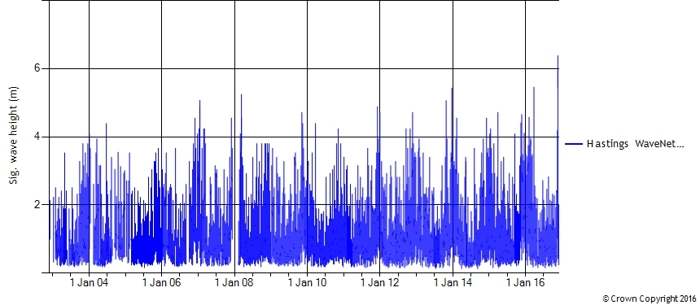
A graph of all Hasting buoy waves since 2003. The 6.4m measured beat the previous highest record of 5.5m.
As it was early in the season, beaches were in excellent condition, so the effects were restricted. The worst hit location was Normans Bay East where undoubtedly there must have been a degree of overtopping. 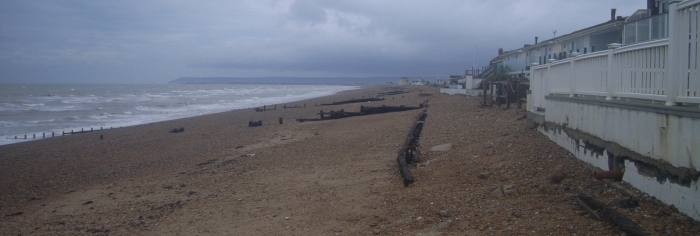
Erosion at Normans Bay East on Monday 21st November 2016
An additional storm on Monday evening didn't cause any additional problems, and after that the weather calmed down. It was so calm in fact that shingle drawn down the beach by Angus has only returned halfway up the foreshore. By the end of the month, most areas were left with a substantial berm, which temporarily retained ribbon lagoons at high water.
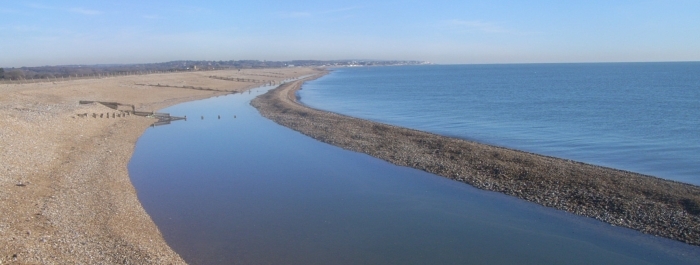
A berm of shingle east of Normans Bay outfall and trapped lagoon disappearing off towards Cooden
Third Considerate Constructors Gold Award
May 2016
For the third year running, the Pevensey Bay Sea Defences project has been given a Considerate Constructors Gold Award. According to scheme organisers, this makes the site the most decorated in the scheme's history.
Pevensey Groynes at Hampton Court Flower Show
July 2015
A garden designed by John Humphries and Andy Hythe has won Best Conceptual Garden, and a Gold Medal, at the RHS 2015 Hampton Court Flower show. The Environment Agency and Pevensey Coastal Defence supported the duo by providing old groyne timbers for use in their "Equilibrium" garden. They described the concept thus;
"Britain’s ancient peoples understood the importance of their relationship with the sun and moon and the effects of those elements on the seasons and tides. Equal opposing forces working in balance was as critical then as it is now.
Henges were spiritual structures and possibly enabled the prediction of celestial events, such as the solstice and equinox. They were a place to heal, celebrate ancestry and the cycle of life. These monuments are testament to peace and harmony.
Equilibrium garden design reflects these themes creating a sensation of well being, calm, stability and balance of the elements. Redundant groynes that have been sculpted by the sea and bleached by the sun are used for their natural beauty to create a henge. Together with the beach and flowers they surround and protect the pool and eternal flame within. The garden encapsulates serene mirage-like days when the wind sleeps and time seems as still as the sunlit sea.
The plants used are those that grow naturally by the sea and have evolved to thrive in the challenging coastal environment, enhancing its subtle beauty."
This is the second award winning garden at Hampton Court to have used old Pevensey Bay groynes. Barry Chambers also won a Gold Medal for his English Poet's Garden in 2011.
Re-use of Harbour dredgings
May 2015
The Marine Management Organisation (MMO) has approved a variation in the site’s FEPA license to allow sand dredged from Sovereign Harbour’s entrance to be placed close to the shore at Pevensey Bay Sailing Club. Approximately 1km east of the marina, depositing sand here rather than 2.5km out to sea will hopefully allow this sediment to return to the nearshore, where it will continue to be beneficial in maintaining Sussex’s sea defences.
In total 17,000 cubic metres of sand was reused in this way during the second half of April. Although this is a relatively small amount in the greater scheme of things, over time it is hoped that continued monitoring of the foreshore will demonstrate that this sand does indeed return to sand bars near the toe of the beach.
Circles in the picture above show where each of the 22 deliveries was made, in a zone 150m wide and stretching up to 900m from the beach. The green lines represent a survey taken in May, and this shows that sea bed levels have changed by no more than 0.3m. Due to the high mobility of this material, it is anticipated that within a few months little evidence will remain that it had been placed in the deposition zone. The challenge will be to find where it goes to!
PCDL are grateful to the Environment Agency and The Crown Estate in their continued support for this research experiment
Second Considerate Constructors Gold Award
May 2015
For the second year running, the Pevensey site has been given a Considerate Constructors Gold Award. This year 99 sites reached this standard from over 8,900 registered with the scheme, which still places the project in the top one per cent.
Indonesian NCICD Delegation
September 2014
The northern part of Jakarta, the Indonesian capital, is expected to subside up to 5 meters below sea level. This problem is being addressed by a National Capital Integrated Coastal Development program (NCICD), which provides an integrated approach to flood protection, improved sanitation and water supply, improved connectivity and sustainable community development in the metropolitan coastal area.
A delegation of government officials and engineers has been engaged in a series of fact-finding visits around the world to learn how best to go about implementing the plan. A visit to Pevensey on Sunday 21st September was used to learn how a PPP contract could be of benefit. Other locations visited included; St Petersburg flood protection barrier; New Orleans storm surge barriers and pumping stations built following Hurricane Katrina; the New York flood defence system, before attending the Rotterdam Delta Conference (24-26 September 2014).

Gold Considerate Constructors Award won
May 2014
The Pevensey site has a Considerate Constructors Award in each of the last eight years, with a total of nine awards altogether. For the first time the site received the highest level of award for 2014 at a ceremony in London. Only 90 sites reached this standard from almost 9,000 registered with the scheme, which places the project in the top one per cent. News of the award was covered by the Eastbourne Herald here.
Crown Estate Research Project - Results
March 2014
Results from The Crown Estate funded project to evaluate the rate at which sediment seems to be disappearing from the lower foreshore were published in March.
Unfortunately, a detailed analysis of what is happening proved impossible without access to additional data that had not been collected. Although over a hundred beach surveys are available to be analysed, knowledge of inshore currents is required before an assessment of how sand moves around the lower foreshore can be made.
The existing surveys do suggest, however, that up to 8,000 cubic metres of sand is being lost from the lowest parts of the beach every year. Whether this is entirely due to natural process or is in part as a result of maintenance dredging at Sovereign Harbour is still unknown.
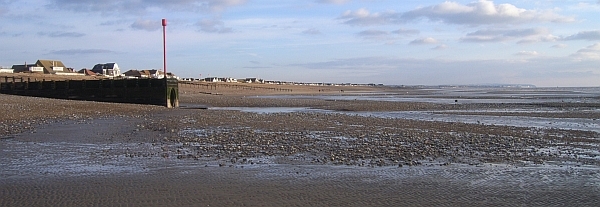
Crown Estate Research Project
September 2013
The Pevensey team has been working with The Crown Estate to evaluate the rate at which sediment seems to be disappearing from the lower foreshore.
PCDL has been undertaking monthly quad bike surveys for more than 10 years. Mostly the monitoring is focused on the main embankment, which after all provides the defence against storms. However, it is recognised that finer sediments migrate freely into and out of the embankment at various times of the year. Equally, sand bars sometimes appear well above low water. At others they remain beyond the reach of the quad bike doing the survey.
It is therefore quite important to understand what long term forces are acting on the lower foreshore (the bit below the embankment)and what effect this may have on the stability of the embankment itself.
As owners of the seabed, The Crown Estate is also interested in what is happening, with particular relevance to beaches adjacent to ports and harbours where maintenance dredging removes material from the inshore ssediment system. The Crown Estate thus agreed to fund a study by Professor Dominc Reeve of Swansea University, who will evaluate all available data to try and determinme what exactly is happening. He is expected to report his findings in November this year.
Bronze Considerate Constructors Awards won
May 2013
The Pevensey site won a 2013 bronze award at a ceremony in London, winning an award for the seventh successive year, and a ninth in total. A bronze for 2013 means that the site has remained in the top 7% of all sites since 2006.
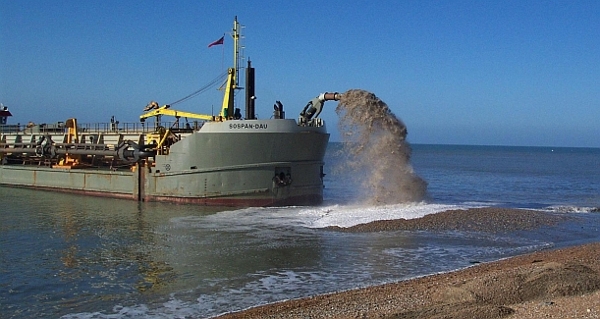
Annual Eastbourne Maintenance
April 2013
As part of Eastbourne's approved 5 Year Beach Management Strategy, this month will see the next round of beach replenishment shingle being added to seafront beaches.. Pevensey Coastal Defence Ltd. are carrying out the works on behalf of Eastbourne Borough Council as part of the Coast Protection Maintenance Contract. The total estimated replenishment volume required is 9,750 cubic metres.. Dredger Sospan Dau, a familar site to those living in Sovereign Harbour and Pevensey Bay, will be returning for her second year maintaining Eastbourne's beaches Incidentally she will be staying in the area to undertake the annual dredge of Sovereign Harbour immediately afterwards.

2013 Considerate Constructors Awards Announced
February 2013
Considerate Constructors Scheme organisers have announced that the Pevensey site will receive a 2013 award. Performance of all registered companies is reviewed annually and the top performing 7% are presented with an award each year. The sea defence scheme has been informed it will be receiving an award for the seventh consecutive year in May, although whether Gold, Silver or Bronze won't be known until the ceremony.
Unusual Storm Hits Pevensey
December 2012
Winter storms are hardly uncommon, but the one occuring on Friday 14 December was quite unusual. Prevailing winds from the south-west mean that the majority of our storms come from the same direction. Tucked in the lea of Beachy Head, Pevensey is often protected from the worst of the weather. On this occasion waves were form almost exactly south east, meaning they came directly onshore. Statistically this event was at least a 1:20 year storm - probably much higher - but equated to about a 1:8 year storm from the south west.
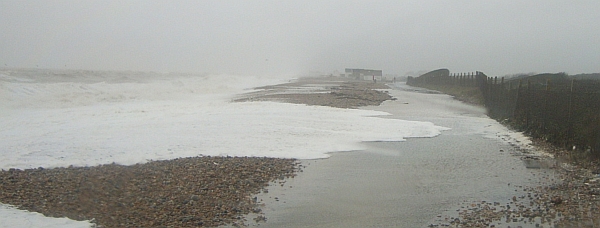
Herbrand Walk, Cooden was covered in shingle as waves swept across pushing debris up to and through the railway fence.
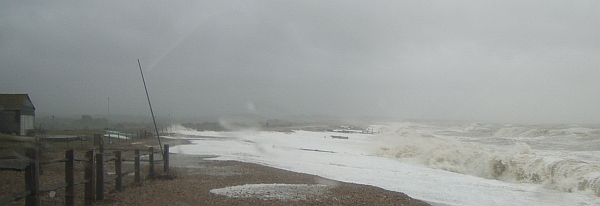
At Normans Bay waves were getting well onto the top of the crest and travelling more than 10m across.
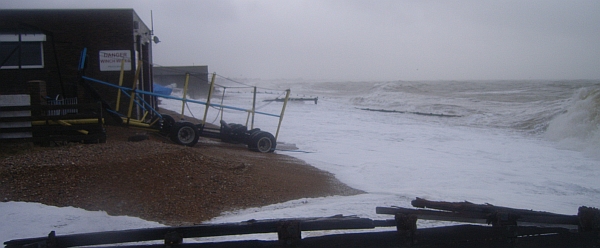
On the western edge of Pevensey Bay village at Grey Towers, waves reached the doors of the two boat houses
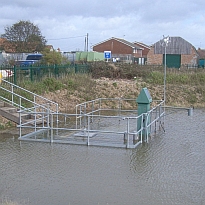
Very High Tides
October 2012
On 17 October 2012 water levels for the noon high water almost reached 4.5mOD, which is only 0.8m below the concrete level outside the PCDL office! Although this was already a high astronomical tide of 4.2mOD, what really made the difference was a 0.3m surge at the time of high water. Luckily the worst of the wind and waves stayed away for the peak of the tide otherwise things would have been far worse. It is difficult to say for sure (because lots of the highest tides occur at night) but it is likley that this particular tide was one of the three highest in the last 12 years. It is not often that the chamber housing the outer sea doors for the Salt Haven river is seen completely under water.

Boskalis Westminster Ltd
October 2012
On 1 October 2012 Westminster Dredging became Boskalis Westminster. Already part of the Royal Westminster Boskalis Group, the largest dredging contractor in the world, the change of name is part of a global rebranding of the Boskalis Group that captures the wide variety of marine services they can offer worldwide.




